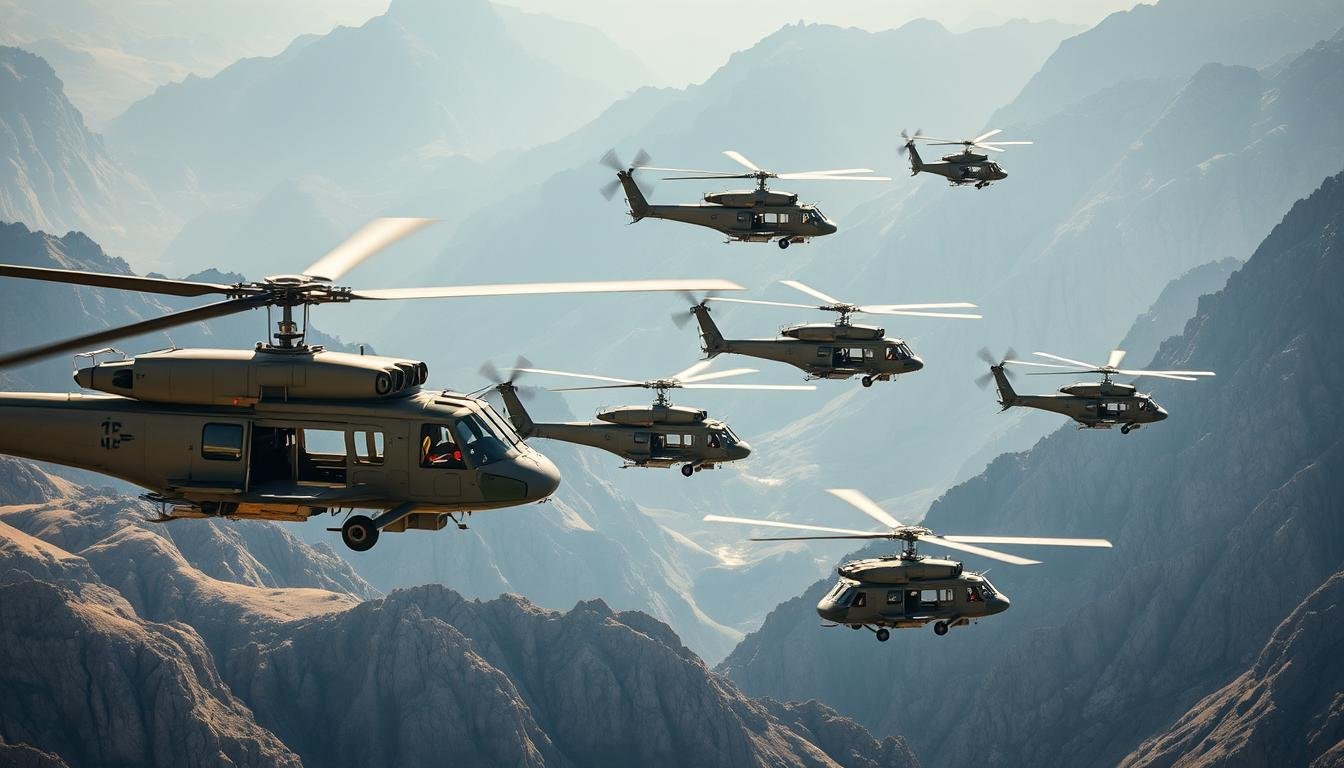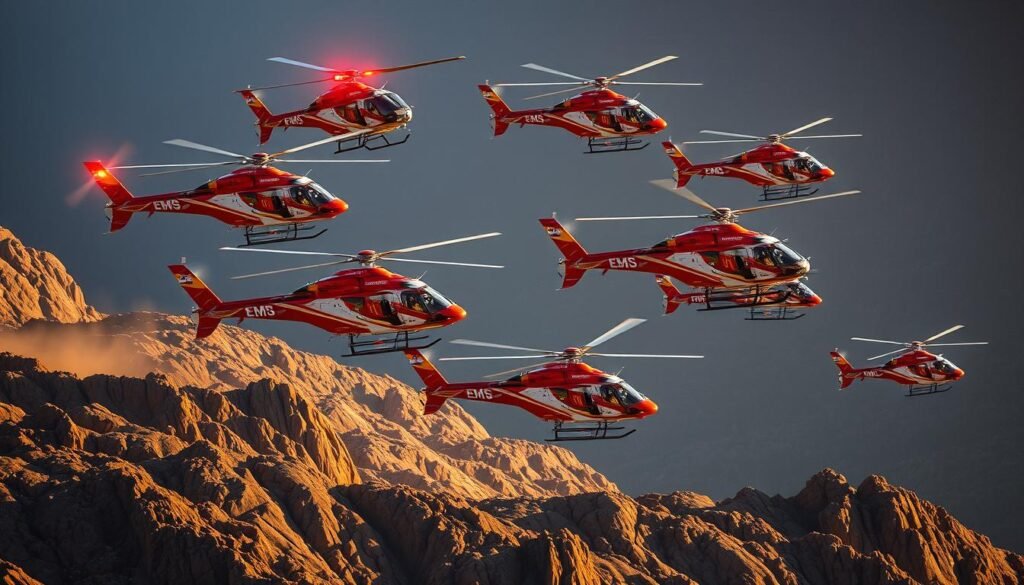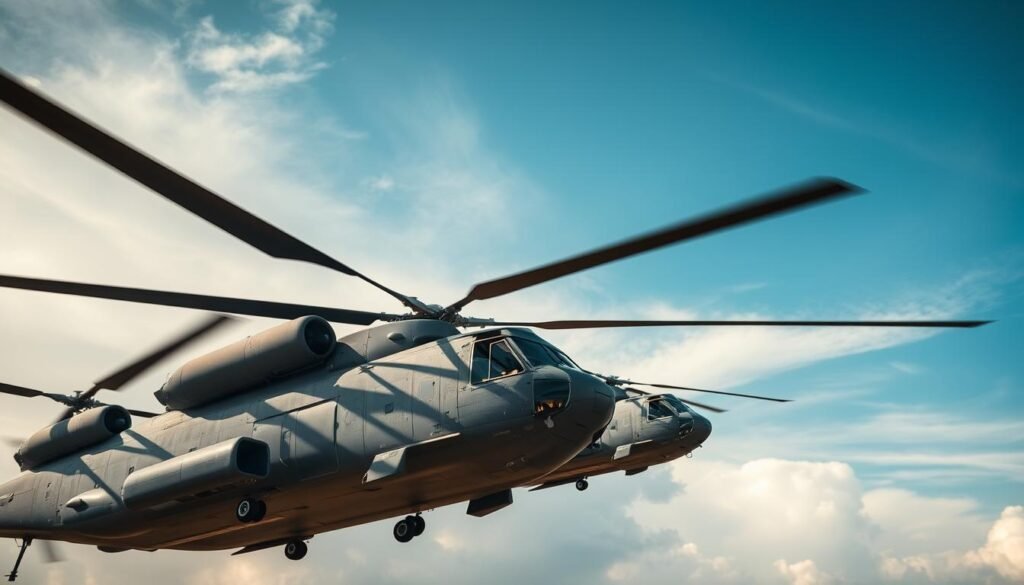Utility helicopters move more than cargo and crews; they close critical gaps where roads and runways fail.
These aircraft lift loads to alpine ridgelines, ferry teams offshore, and deliver supplies to remote sites. They shift quickly between passenger, cargo, and specialty interiors.
Modern avionics, external load kits, and hoist systems let operators complete complex missions with fewer sorties and better safety margins. OEM support and aftermarket parts keep fleets ready and reduce downtime.
Models like the AS350 family illustrate high power-to-weight performance and quick reconfiguration for aerial work. For more on a proven platform, see the AS350 review at AS350 B2.
Key Takeaways
- They provide versatile lift and precise load placement in tight zones.
- Modular interiors enable rapid role changes between missions.
- Proven airframes and OEM ecosystems cut maintenance time and cost.
- Redundant systems and mission kits enhance safety in harsh terrain.
- Fleets scale from light singles to medium twins to match demand.
Utility Helicopters In Demanding Missions Across U.S. Environments
When roads end, rotary-wing aircraft step in to move crews, cargo, and critical equipment into hard-to-reach places.
Construction Lifts And External Load Operations
Certified cargo hooks and sling systems let crews place HVAC units, towers, and concrete buckets with precise hover control. Radio-guided rigging reduces crane time and shortens project schedules.
Personnel Transport To Remote Or Inaccessible Locations
Crew moves to mountaintops, islands, and desert pads cut multi-hour treks into minutes. Strict manifest control and weight-and-balance margins keep flights safe and compliant.
Cargo Transport Where Ground Access Is Limited
Sling-loads and internal cargo runs deliver telecom gear, spares, and building materials to isolated sites. Sortie planning accounts for density altitude and turnaround windows for steady operations.
Aerial Firefighting Support With Water And Retardant Drops
Type-rated platforms cycle between dip sites and fire lines using buckets or tanks. Integration with incident command and airspace deconfliction is critical for extended fire campaigns.
Search And Rescue With Hoist And Winch Extraction
Hoist-equipped aircraft enable extractions from cliffs, canyons, and water. Stabilized hover, crew coordination, and medical setups support patient care en route.
Offshore Oil And Gas Transport For People And Equipment
Flights to platforms emphasize weather minima, overwater survival, and manifest tracking. Twin-engine compliance and cargo provisions meet regulatory demands and client needs.
Logging Support In Rugged Terrain
Precision longline work lifts timber from steep slopes to processing sites. This reduces roadbuilding and lowers ground impact while improving site safety.
Rugged, All-Weather Operations And Specialized Training
Standardized programs cover inadvertent IMC, external-load discipline, wildland fire tactics, and SAR hoist safety. Consistent training keeps crews ready across diverse U.S. environments.
| Mission Type | Typical Platform | Key Mission Kit |
|---|---|---|
| Construction & External Load | Bell 407 / H125 | Cargo Hook, Longline, Rigging Radios |
| Firefighting | AS350B3+ / Bell 412 | Buckets, Belly Tanks, Retardant Systems |
| SAR & Offshore Transport | Bell 429 / 412EPX | Hoist, Flotation Gear, Survival Kits |
Further reading: detailed operational examples appear in the industry guide to helicopter utility work, the engine-performance outlook that shapes future mission capabilities, and modern case studies on rescue operations.
Capabilities And Platforms That Power Your Operation
Selected airframes combine payload, power, and cabin flexibility to match varied field tasks across the U.S.

Bell 505: Quick-Change Cabin For Crew, Customers, Or Cargo
The Bell 505 swaps interiors in minutes, moving from sightseeing to cargo or light external loads. Modern avionics and low operating costs make it a cost-effective choice for short-turn missions and mountain supply runs.
Bell 407GXi: Speed, Power, And External Load Performance
The 407GXi offers higher power margins and cruise speed. That translates to stronger hook performance and faster cycle times for line construction, fire support, and remote access missions.
Bell 429: Safe, Reliable, And Modular For Challenging Environments
The Bell 429 provides twin-engine redundancy, modular cabin layouts, and intuitive displays. Teams convert it for EMS, SAR, or utility insertions in congested or mountainous airspace with confidence.
Subaru Bell 412EPX: Upgraded Torque And Payload For Mission Success
The 412EPX brings increased torque and usable load. That improves hot-and-high performance and extends capability for firefighting, offshore runs, and multi-crew operations.
Airbus H125/AS350B3+: High-Altitude Utility Workhorse
The H125/AS350B3+ is proven for high-altitude tasks. It excels at precision external-load work and mountain access where density altitude challenges single-engine performance.
| Platform | Strength | Typical Role | Notable Kit |
|---|---|---|---|
| Bell 505 | Quick-change cabin, low cost | Touring, light cargo, external load | Cargo hook, modern glass |
| Bell 407GXi | Speed, power margin | Line construction, fire support | Longline, reinforced hook |
| Bell 429 | Twin reliability, modularity | EMS, SAR, offshore | Hoist, flotation, NVG-ready |
| 412EPX / H125 | High payload / high-altitude | Firefighting, mountain access | Buckets, wire protection |
Service, Procurement, And Configuration Options
Fleet buyers balance mission fit, lifecycle cost, and support networks when choosing an airframe. This approach reduces downtime and aligns acquisition with operational needs in U.S. environments.

Configurations: Air Medical, Law Enforcement, Offshore, Training, Utility, VIP
Configurations range from air medical interiors with stretcher mounts and dedicated medical power to VIP cabins with executive seating and sound treatments.
Law enforcement kits add FLIR, searchlights, and data downlinks. Offshore packages supply flotation, overwater survival gear, and rigged seating for platform transfers.
Training models feature dual controls. Utility fits include cargo hooks, longline rigs, and reinforced floors for external-load work.
Procurement Paths: New, Used, Lease, Or Purchase With U.S. Support
U.S. buyers can pursue new builds, purchase used airframes, or opt for lease structures to match cash flow and utilization.
Leasing helps stage fleet growth and align maintenance events with revenue cycles. New purchases deliver OEM warranty and configured support packages.
Filter Criteria: Manufacturer, Model, Year, Total Time, Condition, Region
Market shortlists usually begin with Manufacturer and Model, then refine by Year and Total Time to balance depreciation with remaining life.
Condition filters (New, Used, Salvage) and powerplant choice (Piston or Turbine) determine entry cost and mission capability.
| Filter | Typical Options | Why It Matters |
|---|---|---|
| Manufacturer | Airbus, Bell, Leonardo, MD, Robinson, Sikorsky | Parts network & OEM support affect downtime |
| Model | H125/AS350B3+, EC135/145, Bell 505/407/429/412, AW119/139 | Mission fit and resale value |
| Condition / Powerplant | New / Used / Salvage; Piston or Turbine | Refurb cost, performance, and operating margins |
Service and support networks—domestic parts sourcing, A&P training pipelines, and MRO access—shorten downtimes and stabilize operations. Buyers verify serial and registration records to check AD/SB status before LOI and prebuy inspections.
Conclusion
A disciplined platform selection, keeps crews safer and mission timelines predictable across varied U.S. environments.
Decision-makers should map payload, altitude, and range to proven models like the Bell 505, 407GXi, 429, 412EPX, and the Airbus H125/AS350B3+ to secure stronger performance and lower risk.
Configurations — hoists, hooks, upgraded avionics, and interiors — let one airframe cover multiple taskings while preserving readiness and compliance.
Procurement strategies that blend new, used, and lease options de-risk growth and align capital with utilization.
With domestic inventory and support, operators can onboard capability quickly, train crews effectively, and sustain safe, efficient operations.
FAQ
What roles do these workhorse aircraft perform in U.S. operations?
They support a wide range of missions, including external load lifts at construction sites, transporting crews to remote locations, moving mission-critical cargo where roads are impractical, providing aerial firefighting support with buckets or retardant systems, conducting search-and-rescue with hoists, and servicing offshore energy platforms. Operators select configurations and crews based on mission profile, payload, and environmental demands.
How do platforms differ for high-altitude versus offshore missions?
High-altitude work favors engines and rotor systems rated for thin air and steep approaches; models like the H125/AS350B3+ excel in mountain or hot-and-high conditions. Offshore missions require corrosion-resistant materials, flotation systems, and NVG-compatible cockpits for night operations. Transport reliability, range, and certified maritime equipment drive platform choice.
What configuration options are available for medevac, law enforcement, and VIP roles?
Modular cabins allow quick role changes. Air medical setups include stretcher mounts, medical gas, and monitor power. Law enforcement layouts prioritize observation windows, hardpoints for cameras, and secure seating for tactical teams. VIP interiors focus on soundproofing, climate control, and ergonomic seating. Maintenance and certification paths differ by configuration.
What procurement paths exist for agencies and companies in the U.S.?
Buyers can acquire new models directly from OEMs, purchase inspected used airframes, or lease aircraft for short- to long-term needs. Fleet support and parts supply within the U.S. are critical considerations; warranties, local service centers, and factory-backed training reduce operational risk.
How should operators filter options when choosing a model for their mission?
Filter criteria should include manufacturer reputation, specific model capability, year and total time on airframe, maintenance history, configuration compatibility, and the region of operation. Matching payload, range, and environmental certifications to operational demands ensures mission success.
What mission planning elements reduce risk in rugged, all-weather environments?
Effective planning includes up-to-date weather briefings, terrain and obstacle analysis, weight-and-balance checks for external loads, contingency fuel and diversion routes, and crews trained in mountain, maritime, or night operations. Regular simulator and hands-on training improves response in degraded conditions.
How do external load and logging operations manage safety and efficiency?
Operators use certified cargo hooks, cargo slings, and loadmasters to calculate dynamic loads and ensure secure attachment. Preflight inspections, clear ground signaling, and communication protocols optimize efficiency. Choosing a model with strong lift margins and responsive controls improves safety when moving heavy or awkward loads.
What maintenance and support considerations affect long-term serviceability?
Long-term serviceability depends on established maintenance programs, access to OEM parts, available certified technicians, and upgrade paths for avionics and powerplants. Programs that track time-between-overhaul, corrosion prevention for maritime use, and documented airworthiness records preserve value and minimize downtime.
How do operators decide between upgrading an existing fleet and purchasing a new airframe?
Decision factors include mission changes, remaining airframe life, upgrade costs versus new acquisition price, availability of modern avionics and efficiency gains, and total cost of ownership. Financial models should account for fuel burn, maintenance cycles, and resale value under current market conditions.
What training and certification are required for crews performing search-and-rescue and hoist extractions?
Crews need type-specific flight training, hoist and winch operation qualifications, rescue swimmer and hoist operator instruction, and proficiency checks that include night and degraded-visibility procedures. Agencies often follow FAA and U.S. Coast Guard guidance for mission readiness and recurrent training intervals.ical to the industries that rely on them to get the job done.
Related Articles
- Medical Transport Helicopters: Critical Features and Models for Emergency Flights
- Helicopter Drones: The Future of Unmanned Aerial Systems
- Helicopters for Offshore Oil and Gas Operations: Transporting Workers and Equipment
- Helicopters in Tourism: The Best Models for Scenic Tours
- Helicopters for Police and Law Enforcement: Surveillance and Patrol Capabilities
More from This Category
- The Evolution of Attack Helicopters: Key Models and Their Capabilities
- Utility Helicopters: The Workhorses of the Sky
- Trainer Helicopters: The Best Models for Learning to Fly
- Helicopters for Aerial Photography and Filmmaking: Top Picks for Capturing the Perfect Shot
- Luxury Helicopters: The Best Models for Private and Corporate Use
- Heavy Lift Helicopters: Moving Large Cargo and Equipment
- Agricultural Helicopters: Aerial Spraying and Crop Management
- Rescue and EMS Helicopters: How They Save Lives in Critical Situations
- Military Helicopters: Key Models and Their Combat Roles
- The Different Types of Helicopters: From Light Utility to Heavy Lift



